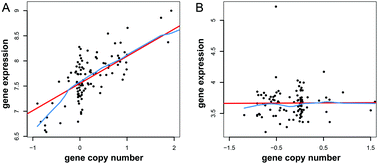The functional consequences and prognostic value of dosage sensitivity in ovarian cancer†
Abstract
Copy number alteration (CNA) represents an important class of genetic variations that may contribute to tumorigenesis, tumor growth and metastatic spread. CNA can directly affect the expression of genes within the CNA regions; however, genes within the CNA regions exhibit heterogeneity in gene dosage sensitivity. In this study, a computational framework was built to identify 1170 dosage-sensitive genes (DSGs) and 1215 dosage-resistant genes (DRGs) that were related to ovarian serous cystadenocarcinoma (OV) through the association between CNA and gene expression. To analyze the different functions of the genes within the two groups, the functional annotation results indicated that DRGs were involved in cancer-related processes like immune response, cell death and apoptosis, while DSGs were enriched in essential processes like the cell cycle and the DNA metabolic process. Meanwhile, two three-dimensional regulatory networks for differentially expressed miRNAs, differentially expressed transcription factors (TFs) and DSGs or DRGs were constructed based on feed-forward loops. We identified key regulators (such as miR-16-5p, miR-98-5p, MYB and HOXA5) and cancer prognosis-related network motifs (such as miR-98-5p-HOXA5-TP53 and miR-16-5p-MYB-IGF1R) after the analysis of network topological features. Our results lead us to speculate that these genes and associated regulators may be potential mechanistic biomarkers for tumorigenesis and progression of cancer. Research on the network characteristics and the role of feed-forward loops in OV tumorigenesis and development could lead to feasible suggestions for the prevention and early diagnosis of OV, which will shed light on understanding the functional mechanism of CNA in cancer.



 Please wait while we load your content...
Please wait while we load your content...